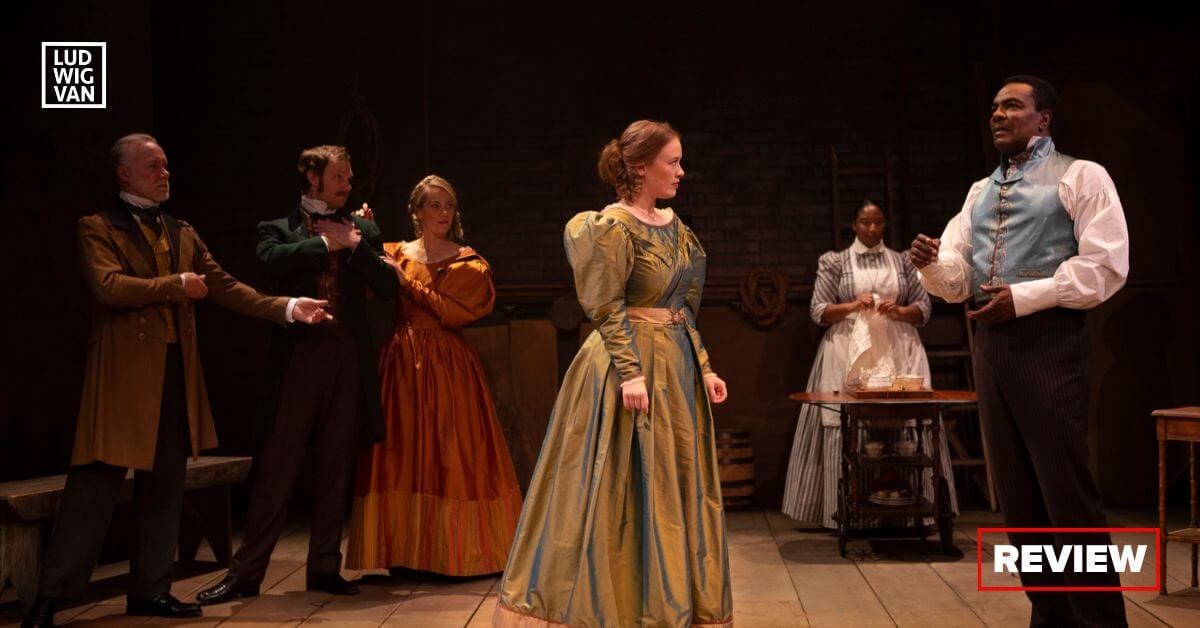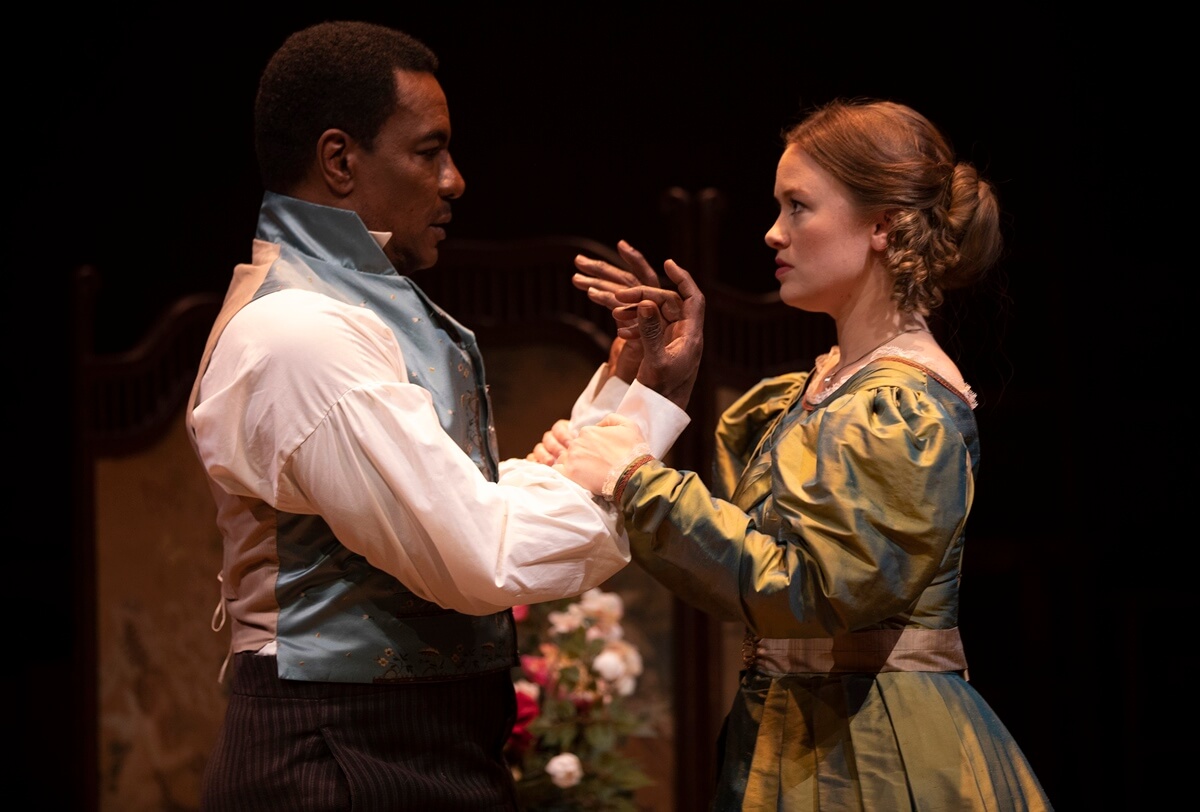
Crow’s Theatre/Red Velvet, written by Lolita Chakrabarti, directed by Cherissa Richards, Guloien Theatre, Streetcar Crowsnest, Nov. 22 to Dec. 18. Tickets here.
The definition of a great playwright is someone who can take two lines of a biography, a blip in a life, so to speak, and transform the incident into an entire play with profound levels of meaning.
Such is British wordsmith Lolita Chakrabarti and her play Red Velvet (2012).
The centrepiece is an event that took place in 1833 at London’s Theatre Royal, Covent Garden. The play was Shakespeare’s Othello, featuring African-American actor Ira Aldridge in the title role. He was, in fact, the first Black man to perform Othello in London.
Aldridge (1807—1867) had stepped in for the much beloved British actor and tragedian Edmund Kean, who had previously collapsed on stage. It was a very controversial casting decision, to say the least. Aldridge, just 26 at the time, was met with vicious criticism, a great deal of it racially motivated. The run was cancelled after two performances, although audiences were enthusiastic.
In all my research, only one article mentioned the Theatre Royal incident, and that was just in passing. Rather, the many other biographies focused on Aldridge’s outstanding career as an actor, playwright and theatre manager, which took him all over Britain and the continent, where he performed before the crown heads of Europe.
Here’s a short backgrounder on Aldridge, who became a naturalized British citizen in 1863.
He was born in New York City to free parents, and started acting in rough-and-tumble Black theatres as a youngster. With severe discrimination forcing Black actors to the margins, he sailed to England in 1824 when he was 17 in search of a career. Almost immediately, he was cast in various roles at London’s Royal Coburg Theatre (now the Old Vic).
After the Theatre Royal debacle in 1833, Aldridge prudently played the provinces to hone his craft. His fame gradually increased, and by 1852, he was lionized all over Britain. Looking for fresh pastures, he headed for continental Europe, with the occasional forays back to Britain.
Aldridge died in Lodz, Poland of a lingering lung condition in 1867, so he never got to return to the country of his birth, where he had planned a 100-city tour in post-Civil War America. His grave in Lodz is lovingly tended by the Society of Polish Artists of Film and Theatre. Aldridge is the only Afro-American actor honoured with a bronze plaque at the Shakespeare Memorial Theatre in Stratford-upon-Avon.
That is where truth ends and Chakrabarti’s fiction begins, and what a masterful story she has fashioned. The first act of Red Velvet engulfs you, envelops you, thrills you. The second act is one of the saddest I have ever witnessed. Red Velvet is a total emotional theatre experience.
The play begins in Poland in 1867, where eager young reporter Halina Wozniak (Amelia Sargisson) is trying to interview Aldridge (Allan Louis), about the 1833 fiasco, which is our first clue about this dark event in his past.
We then cut back to 1833, as French-born manager Pierre Laporte (Kyle Blair) introduces Aldridge as Kean’s replacement to the shocked Theatre Royal company (Nathan Howe, Patrick McManus and Sargisson). Always watching and observing in silence is the theatre’s West Indian Black maid Connie (Starr Domingue).
Blind anger is reserved for Charles Kean (Jeff Lillico), son of Edmund, who thought he’d be taking over the role of Othello. Particularly galling is that his fiancée, Ellen Tree, will be playing Desdemona opposite this Black man, and she will be physically touched by him.
(In reality, Edmund Kean was a fan of Aldridge’s, while Aldridge and Charles performed together many times. Ellen and Charles did ultimately marry.)
And so Chakrabarti sets up her situational conflicts. Halina bemoans gender inequality in a newspaper staffed by men. Laporte and Aldridge’s friendship is sorely tested. Connie finally gets her say. The whole play is set against the great debate about the abolition of slavery in the British Empire, and we are aware of the protests raging outside the theatre.
Meanwhile, Charles becomes almost pathological about the growing relationship between Ellen and Aldridge, who first connect in a lively conversation about how to play their scenes together. Aldridge’s pitiful, lower class wife Margaret (Sargisson again) silently witnesses the sexual chemistry between Ellen and her husband.
The play also has its humorous side. The passages where the company discusses various competing acting styles are an absolute delight. Here, Chakrabarti layers in contemporary references as inside jokes for the audience. It is all very amusing.
Deep inside the play, however, is the soul of a man. It would be very easy to put all the blame for the failure of Aldridge’s 1833 Othello on the London critics and the skittish board of the Theatre Royal, but Ellen and Aldridge contribute their fair share. The playwright also gives Aldridge a fatal flaw, the prerogative of any artist, and she poses the theory that perhaps he was, in some way, the architect of his own fate.
There are so many themes running around Red Velvet that are relevant to today. Gender and racial equality. The individuality of artistic expression. Tradition versus the avant-garde. The responsibility of friendship. I could go on and on, but in truth, those two days in 1833 are a mirror of society at large, then and now.
I am continually surprised and delighted by the crop of young new female directors taking their place in Canadian theatre life, and the very talented Cherissa Richards is one of them. Her careful rendering of character and pacing in Red Velvet shows a great command of the stage, and she is a talent to watch. The way she has orchestrated the scene changes is very inventive.
Of course, Richards is helped immeasurably by great acting, with many of the cast coming out of the Stratford and Shaw Festivals. The creds of the actors are long indeed.

Louis as Aldridge is — choose your word — charismatic, magnetic, spell-binding — a brash American among the refined English who knows his worth. His utterly riveting performance sweeps across the stage like a tsunami, whether portraying Aldridge’s vigorous, vainglorious prime, or a dying old man.
Lillico, as his foil, is a bombastic Charles Kean, but his portrayal could have been a one trick pony, had he not found nuance in his lines. He does a heroic effort to make Charles more than one-dimensional. Denny is lovely as Ellen Tree. She is bright, sparkling, clever, vivacious, flirtatious, and more to the point, captivating — every inch the leading lady.
The other key role is Pierre Laporte which could be the most difficult in the play. Actor Blair has to function on several levels. He’s a theatre manager, and must be cognizant of that fact, but he is also a friend to Aldridge. He is a character torn in two, and Blair manages to be both gentle and angry in his portrayal.
(In point of fact, Laporte was manager of the Theatre Royal for less than a year because he had to close the season early due to heavy losses. He did move on to other successful managerial positions.)
The rest of the cast makes for a very good ensemble, supporting the lead actors, but adding in their own personalities as well. Howe, McManus, and particularly Sargisson, do a very good job performing several roles, although Sargisson needs a stronger voice. The stage pulses with life from beginning to end — another credit to director Richards and her cast.
Set designer Julie Fox has cleverly given us a proscenium stage with footlights and a swagged red velvet curtain. Stage pieces are added as necessary. It is, in a word, perfect for time and place.
Ming Wong has designed attractive period costumes, Arun Srinivasan has provided the hazy, smoky gaslight effect, while Thomas Ryder Payne’s score is filled with edgy, sawing, discordant music. Fox, Wong and Srinivasan have given us the exteriors, while Payne has given us the subtext.
Chakrabarti’s play is a love letter to the theatre on the broad level, and to artistic courage in the microcosm. It is also a discovery of a long-lost theatrical hero. Few, I wager, have ever heard of Ira Aldridge before.
By fictionalizing characters, imagining relationships, and creating situations of tension, Chakrabarti has manipulated her plot at will, and that is the real cleverness of Red Velvet. As a result, it is the past seen through the lens of today.
As for the meaning of Red Velvet, you’ll have to see the play to find out.
#LUDWIGVAN
Get the daily arts news straight to your inbox.
Sign up for the Ludwig van Daily — classical music and opera in five minutes or less HERE.
- INTERVIEW | Actor Diego Matamoros Takes On Icon Walt Disney In Soulpepper Production Of Hnath Play - April 16, 2024
- SCRUTINY | Opera In Concert Shine A Light On Verdi’s Seldom Heard La Battaglia Di Legnano - April 9, 2024
- SCRUTINY | Lepage & Côté’s Hamlet Dazzles With Dance And Stagecraft Without Saying Anything New - April 5, 2024



